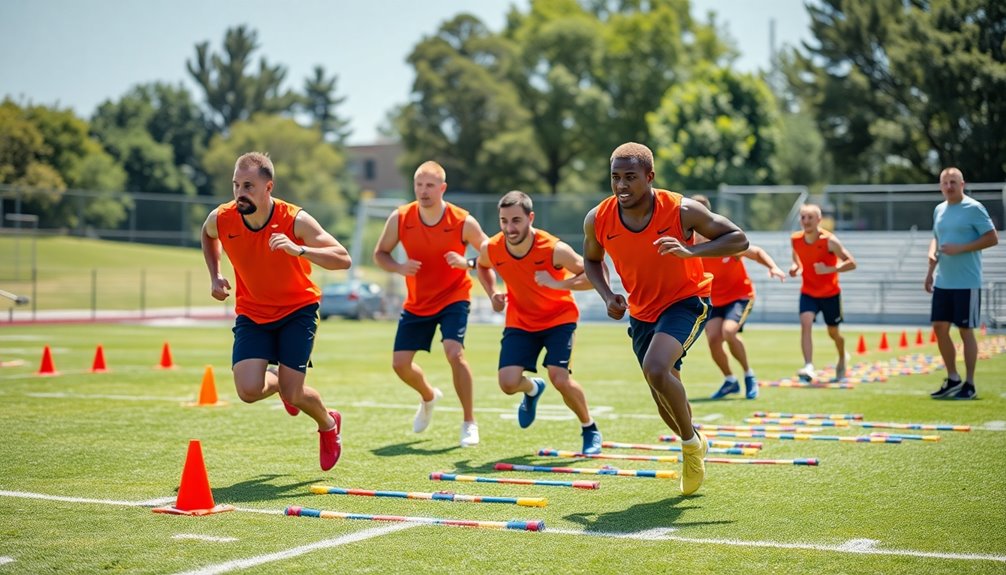
American Football Drills to Boost Team Performance
January 11, 2025To boost your team's performance in American football, focus on targeted drills. Tackling and passing exercises refine skills while promoting injury prevention. Incorporate agility drills like lateral shuffles and cone drills to enhance quickness and speed. Add strength training, such as squats and plyometrics, to build explosive power. Don't forget conditioning drills, like high-intensity interval training, to improve endurance and reduce injury risks. To track progress, use timing devices and video analysis for targeted feedback. Implement these strategies for measurable improvements in performance, and you'll discover more ways to elevate your game with just a few adjustments.
Overview of Football Drills
Understanding the importance of football drills is fundamental for any player looking to improve their game. Drills form the backbone of Football Practice, helping players refine their skills and enhance their performance on the field. Each type of drill focuses on specific aspects of the game, from tackling and passing to conditioning and agility.
Tackling drills are essential for teaching proper techniques, promoting injury prevention, and simulating real game scenarios. They help players understand how to defend effectively while minimizing risks. Moreover, consistent practice of speed and agility drills can significantly enhance defensive capabilities during games.
Passing and catching drills are equally important, as they improve quarterback accuracy and receiver timing, fostering the chemistry needed for a successful passing game.
Conditioning drills play a significant role in building endurance, speed, and stamina. These drills guarantee players can maintain peak performance throughout the game while also supporting injury prevention. Additionally, endurance training methods help develop the stamina required for high-intensity gameplay. This mirrors the cardiovascular endurance needed for sustaining energy throughout matches.
Agility drills further enhance players' quickness and footwork, allowing them to maneuver effectively during gameplay.
Incorporating a variety of drills into your practice routine won't only develop your skills but also strengthen teamwork among players, ultimately leading to improved overall game performance. Embrace these drills as fundamental tools for growth in your football career.
Key Benefits of Conditioning
Conditioning is essential for enhancing your athletic performance on the field. It not only boosts your endurance throughout the game but also considerably reduces your risk of injuries. Additionally, incorporating speed training into your regimen can significantly enhance your acceleration and agility, vital for excelling in competitive play. Regular cardio training improves overall stamina, helping players manage the physical demands of the game effectively. Furthermore, a well-structured warm-up routine can prepare your body for intense activity, minimizing the likelihood of injuries.
Enhanced Athletic Performance
When athletes commit to conditioning drills, they release a range of benefits that can elevate their performance on the field. By focusing on conditioning, you'll enhance your overall athleticism, leading to improved game-day outcomes.
- Increased cardiovascular endurance: You'll maintain high energy levels throughout the game.
- Strength training benefits: This builds muscle mass, explosive power, and core stability, which are essential for effective performance.
- Agility enhancements: Drills like ladder and cone exercises improve your quick movements and reaction times, helping you evade opponents.
- Speed conditioning: Short-distance sprints and resistance sprints enable you to outpace competitors during critical game moments.
- Regular practice: Committing to conditioning 2-3 times a week leads to measurable improvements in speed and agility.
These conditioning drills not only sharpen your abilities but also contribute to your team's overall performance.
Injury Risk Reduction
Injuries can sideline even the most skilled athletes, but committing to regular conditioning drills can greatly reduce that risk. By enhancing muscle strength and joint stability, you can markedly lower your chances of sprains and strains. Engaging in dynamic drills not only boosts your flexibility but also expands your range of motion, allowing you to absorb impacts better during those high-intensity plays.
Incorporating plyometric exercises into your training routine can improve your neuromuscular control, which is essential for quick directional changes on the field. This increased control directly contributes to injury risk reduction, especially when you're executing fast maneuvers.
Additionally, conditioning programs that emphasize agility training can enhance your cardiovascular health, helping you fight off fatigue-related injuries during grueling games and practices.
A well-structured conditioning routine also teaches you better body mechanics, vital for executing complex football movements safely. By prioritizing conditioning, you're not just improving your performance; you're actively protecting yourself from injuries that could derail your season.
Improved Game Endurance
A commitment to conditioning doesn't just help with injury prevention; it also greatly boosts your game endurance. By focusing on conditioning drills, you're setting yourself up to maintain high performance levels throughout the entire game. This means less fatigue and a more effective team on the field.
Consider these key aspects of improved game endurance:
- Cardiovascular endurance training like interval sprints or long-distance runs increases your stamina.
- You'll recover quickly between plays, allowing you to sustain energy during critical moments.
- Conditioning drills enhance muscle strength and power, improving your ability to execute plays under pressure.
- A structured program can lead to a 10-20% increase in aerobic capacity, helping you outlast opponents.
- Consistent training helps reduce the risk of injuries, strengthening your muscles and joints.
Incorporating these elements into your practice won't only enhance your endurance but also contribute to a more resilient and competitive team.
When you focus on conditioning, you're investing in your performance and your team's success. Embrace the grind, and see how it transforms your game!
Dynamic Drills for Agility
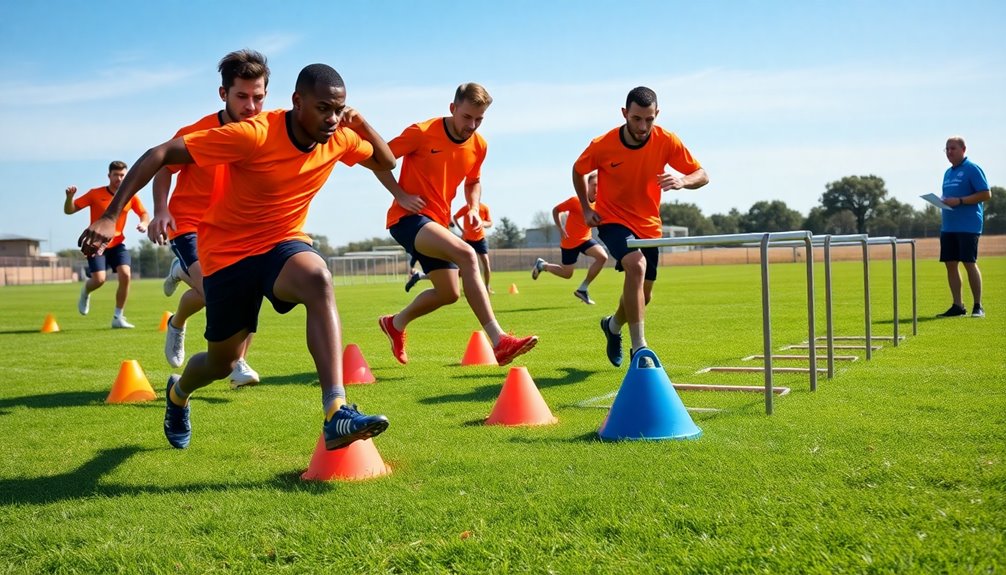
Dynamic movement is essential for football players looking to enhance their agility on the field.
Drills like the Lateral Shuffle to Sprint and Cone Drill are great examples that not only improve your lateral speed but also boost overall conditioning. Incorporating speed, agility, and endurance workouts into your training routine can further elevate your performance on the field. Additionally, dynamic exercises such as high knees and butt kicks can improve circulation and increase heart rate, making them an excellent addition to your warm-up routine. Engaging in dynamic stretches before workouts helps prepare your muscles for the physical demands of football.
Importance of Dynamic Movement
During practice sessions, incorporating dynamic movement drills is essential for enhancing agility on the field.
These drills focus on improving your lateral movements, which are vital for making quick direction changes and executing evasive maneuvers during gameplay. By engaging in dynamic exercises, you can greatly boost your acceleration and sprinting speed, benefiting both offensive and defensive plays.
Consider these key points about dynamic drills:
- They engage multiple muscle groups, improving overall conditioning.
- Enhanced agility leads to quicker reaction times on the field.
- They promote injury prevention by building strength and stability in key muscle groups.
- Incorporating these drills can result in noticeable improvements in player performance metrics.
- Dynamic drills prepare you for high-energy levels throughout games.
Key Agility Drill Examples
When looking to enhance your agility on the football field, incorporating specific drills can make all the difference. One effective exercise is the Lateral Shuffle to Sprint Drill, which helps improve your speed development and first-step quickness. This drill is essential when you need to change direction quickly during a game.
Cone drills are another excellent option; they incorporate resistance to strengthen muscle memory and agility for executing those significant quick cuts. The Back Pedal & Break Drill is beneficial for defensive players, promoting strength at higher velocities, ensuring you maintain speed while shifting.
For lateral power generation, practice the Dynamic Skater Jump Mechanics. This drill focuses on controlled landings and stability, which are imperative for explosive movements on the field.
Finally, the Speed Rush Drill allows you to maintain stable resistance while maneuvering around tackles, enhancing your overall agility and game preparedness.
Strength Training Exercises
Incorporating strength training exercises into your routine is essential for enhancing your performance on the football field. These exercises not only build muscle mass but also improve core stability, which is vital for explosive movements during games. The evolution of player gear has also been pivotal in maximizing performance through improved comfort and protection. Additionally, addressing systemic barriers faced by athletes can further enhance access to effective training environments and resources.
You'll find that dedicated strength training can greatly increase your power output and overall effectiveness as a player. Aim for regular sessions, ideally 2-3 times a week, to reap the benefits. Additionally, integrating high-intensity sprints into your workouts can further enhance your cardiovascular endurance, which is crucial for sustaining performance throughout the game.
Here are some key exercises to include:
- Squats: Build leg strength and stability.
- Deadlifts: Enhance overall power and core strength.
- Plyometrics (e.g. box jumps): Improve explosive power.
- Resistance training (e.g. sleds and bands): Boost muscle strength.
- Medicine ball throws: Increase upper body explosiveness.
Speed and Endurance Drills
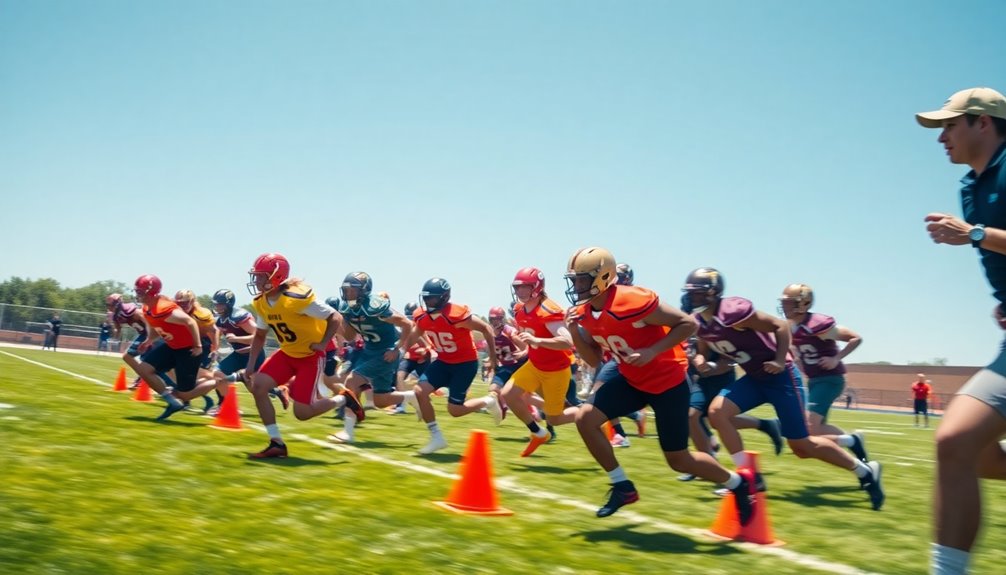
Building strength is only part of the equation for football performance; speed and endurance play an essential role in how well you execute during games. To enhance these attributes, integrate high-intensity interval training (HIIT) sprints into your practice sessions. This method boosts cardiovascular endurance and speed, helping you improve your 40-yard dash times considerably. Additionally, focusing on consistent effort during training ensures that your improvements are sustainable over time. Engaging in dynamic warm-up routines can also prepare your body for these intense workouts effectively.
Incorporating plyometric exercises, like box jumps and jump squats, can also help you develop explosive power and speed. These drills are vital for quick direction changes and acceleration on the field.
Don't overlook resistance training either; drills such as sled pushes or using the VertiMax system build muscle strength and power, translating into better sprinting capabilities and endurance during high-contact scenarios.
Make sure to include regularly scheduled endurance runs combined with interval sprints in your training routine. This approach improves both aerobic and anaerobic capacities, ensuring you can recover quickly while maintaining peak performance levels during games. Additionally, incorporating interval sprints as part of your routine can significantly enhance your overall agility and stamina, making it easier to sustain high energy levels throughout matches.
Position-Specific Skill Development
To excel on the football field, mastering position-specific skills is essential, as each role demands unique techniques and abilities.
Position-specific drills are key to refining these skills during your football training sessions.
- Lateral High Step & Go Drill: Enhances agility and foot speed for running backs.
- Quick Pass Drills: Improves timing, accuracy, and decision-making for quarterbacks under pressure.
- Route Running: Practicing 15 essential routes helps wide receivers create separation and improve reception skills.
- Flag Pulling Drills: Teaches defensive players effective techniques for removing flags, focusing on proper angles and timing.
- Agility Drills: Incorporate these to boost coordination and reaction time for all positions.
Plyometric Training Techniques
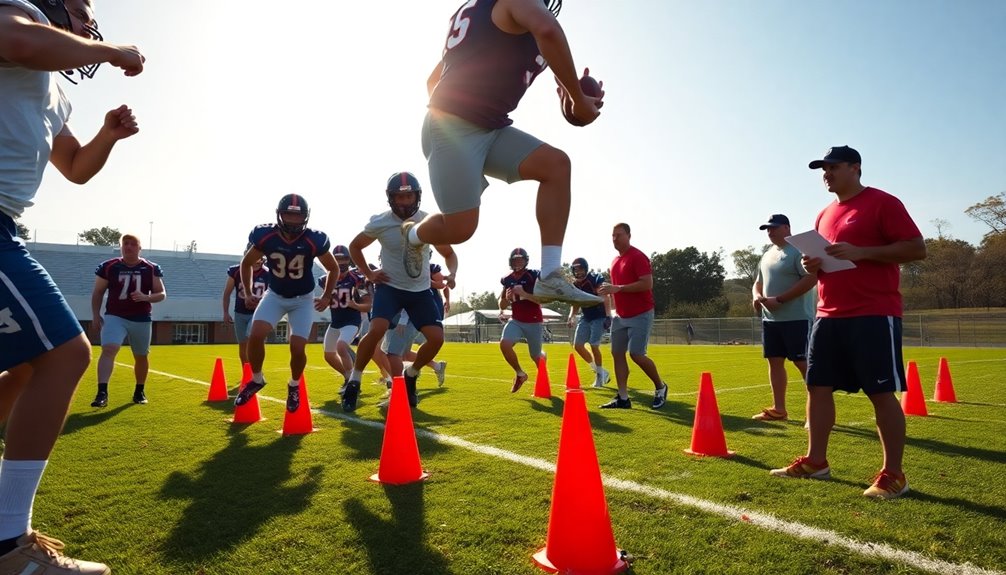
When you incorporate plyometric training techniques into your routine, you're focusing on explosive movement drills that boost your strength and power development.
These exercises not only enhance your athletic performance but also play a key role in injury prevention strategies.
Explosive Movement Drills
Explosive movement drills, or plyometric training techniques, pack a punch in enhancing your athletic performance. By incorporating rapid stretching and contracting of muscles, these drills improve your explosive movements, allowing you to accelerate and change directions more efficiently on the field.
Here's how you can benefit:
- Box Jumps: Boost your vertical jump height by up to 10%.
- Depth Jumps: Train your body to handle impact while improving power.
- Plyometric Push-ups: Increase upper body explosive strength and speed.
- Single-leg Hops: Enhance balance while focusing on muscle fiber recruitment.
- Burpees: Combine strength and cardio for overall muscular endurance.
Engaging in these plyometric exercises 2-3 times per week can lead to significant improvements in your performance metrics.
You'll experience reduced ground contact time, allowing for faster acceleration and agility during gameplay. Regular plyometric training not only increases your muscle fiber recruitment but also enhances your strength and endurance, essential for high-intensity situations.
Include explosive movement drills in your training regimen to elevate your game and keep fatigue at bay during competitions.
Strength and Power Development
Building on the benefits of explosive movement drills, strength and power development through plyometric training techniques plays a vital role in enhancing your football performance. By incorporating exercises like box jumps and depth jumps, you can considerably boost your explosive power, engaging fast-twitch muscle fibers that are essential for sprinting speed and jumping ability.
Research shows that plyometric training can increase muscle power by 5-10% within just a few weeks, giving you a noticeable edge on the field.
To maximize your results, consider utilizing the VertiMax Raptor system, which offers variable resistance to enhance your explosive movements while guaranteeing proper form. Additionally, plyometric exercises improve neuromuscular coordination, allowing you to react faster and more efficiently during critical game situations, whether you're on offense or defense.
A well-structured plyometric training program should include 2-3 sessions per week, allowing for adequate recovery and adaptation. Focus on exercises that mimic the specific demands of football movements to guarantee peak strength development.
Injury Prevention Strategies
While many athletes focus solely on performance gains, incorporating plyometric training techniques can also play an essential role in injury prevention.
These exercises, like jump squats and box jumps, enhance explosive power while strengthening the muscles and tendons around your joints. This dual benefit helps reduce the likelihood of injuries.
Consider these injury prevention strategies through plyometric training:
- Increased muscle elasticity: Improved elasticity contributes to better stability and control.
- Enhanced strength: Stronger muscles lead to a more resilient body during dynamic movements.
- Improved neuromuscular coordination: Better coordination helps you react quickly in game situations.
- Reduced injury rates: Research shows a 30% reduction in injuries for athletes who engage in plyometric training.
- Structured programs: Following a structured program for 6-8 weeks can greatly boost your vertical jump and sprinting speed.
Monitoring Athlete Progress
Monitoring athlete progress is critical for enhancing performance in American football. To effectively track improvements, utilize timing devices during training sessions to measure sprint speed and overall athletic performance. This allows you to pinpoint enhancements and adjust your focus accordingly.
Recording repetitions and resistance levels for each drill is significant. This data helps you assess progress and tailor training regimens based on individual athlete capabilities.
Implementing video analysis also plays a key role; it enables you to evaluate technique, providing targeted feedback that enhances skill execution.
By comparing performance metrics against previous sessions, you can identify trends and set specific goals. This not only motivates athletes but fosters a culture of continuous improvement.
Remember, it's important to adjust resistance levels and drill intensity according to player position and skill level. This guarantees that each athlete receives effective training that leads to optimal performance outcomes.
Ultimately, by consistently monitoring athlete progress, you're laying the groundwork for success on the field. This strategic approach will enhance both individual and team performance, driving everyone towards their best.
Recovery and Nutrition Strategies
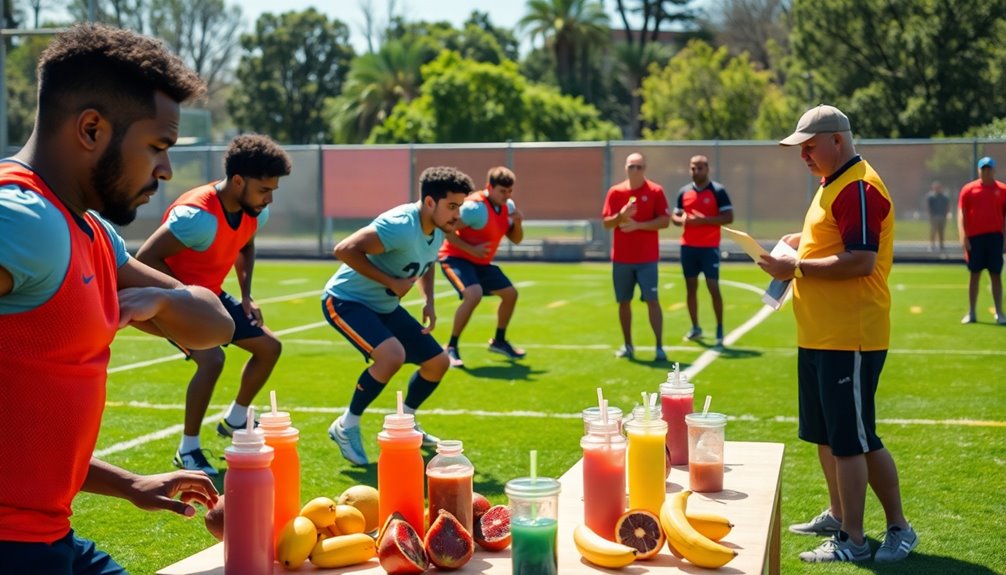
Recovery and nutrition are the cornerstones of peak performance in American football. To maximize your training results and minimize muscle soreness, you need to prioritize both. Here are some key strategies to contemplate:
- Cool-down routines: Incorporate stretching and light activity post-training to reduce muscle soreness by up to 50%.
- Post-training meals: Aim for a balanced meal with a 3:1 ratio of carbohydrates to protein for ideal recovery and energy replenishment.
- Hydration: Drink at least 16-24 ounces of fluid for every pound lost during practice to replace electrolytes effectively.
- Recovery practices: Use foam rolling and massage to enhance muscle recovery time by 30%, which can greatly improve your performance in future sessions.
- Consistent nutrition: Focus on whole foods rich in vitamins and minerals to support muscle repair and boost your overall energy levels.
Incorporating Technology in Training
To achieve ideal performance on the field, integrating technology into training can be a game-changer. Utilizing systems like GoRout greatly enhances practice sessions by boosting repetitions and overall team performance by 2.5 times. This technology streamlines communication, allowing you to focus on executing strategies efficiently.
You can leverage web and mobile apps within the GoRout System to share play calls seamlessly. This improves organization and execution during training, ensuring everyone's on the same page.
Wearable devices further enhance this communication by providing real-time access to play drawings and position-specific messages, helping team members understand their roles better.
Incorporating video analysis tools allows you to evaluate player techniques and performance metrics closely. This leads to targeted training adjustments, ensuring every practice session is effective.
Plus, tracking data from wearable devices enables you to monitor player fatigue and performance improvements. With this information, you can create personalized training regimens that optimize athlete development and enhance team performance.
Enhancing Team Communication
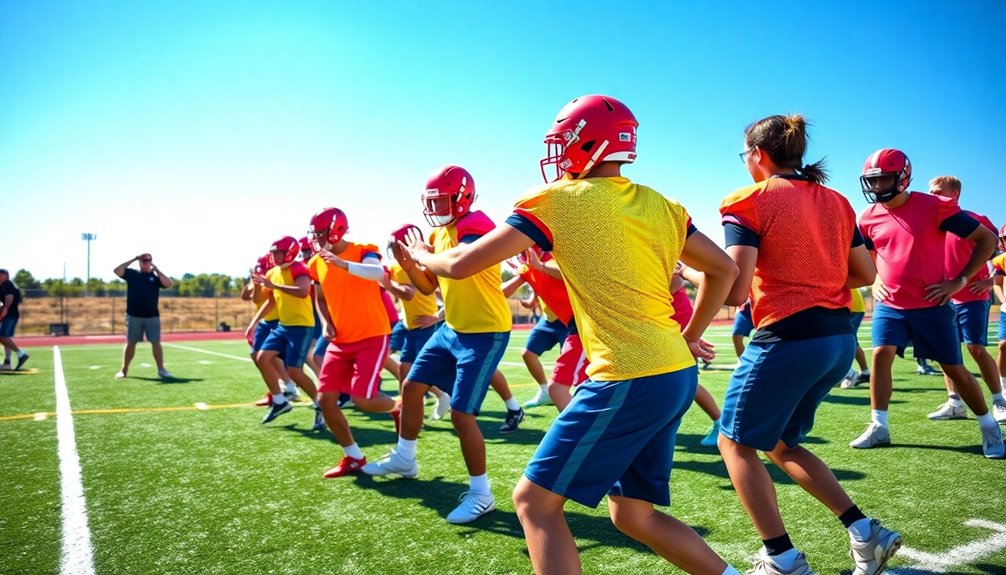
Effective communication is essential for any football team aiming to succeed on the field. When you prioritize team communication, you foster a cohesive unit that understands roles and responsibilities.
This clarity is vital for executing plays effectively. Here are some strategies to enhance communication:
- Utilize verbal cues during drills to improve coordination.
- Implement situational drills that focus on communication under pressure.
- Use technology, like the GoRout system, for instant feedback and adjustments.
- Foster trust and rapport among players to facilitate quick decision-making.
- Emphasize communication in practice sessions to boost practice efficiency.
Conclusion
So, there you have it—your playbook for transforming your team from a bunch of couch potatoes into a well-oiled football machine. With the right drills, strength training, and maybe a sprinkle of tech wizardry, you'll be ready to tackle any opponent… as long as you remember to hydrate and not eat too many nachos during halftime. Who knew becoming a gridiron gladiator could involve so much running and so little snacking? Now, go kick some grass!


